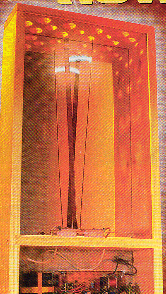
Jacob's Ladder
"Build this exciting Jacob's Ladder and watch electric arcs ascend the ladder and evaporate
in space. It works from a clever 12,000-volt power supply. Author Robert Iannini."
Jacobs Ladder, HV, Tesla, Wimshurst, Voltage Doublers, Kirlian, Lightning Bulb, Van de Graaff
Re-written by Tony van Roon (VA3AVR)
People have long been fascinated by electric arcs--and perhaps put off by
them. They show up as lightning, Tesla coil discharges, and long sparks that sting as you reach for the doorknob on
a cold, dry, winter day. This Jacob's Ladder project turns electric arcs into a dramatic but harmless conversation
piece.
If you build this project, you'll lean how a simple power supply operating from the 120-volt AC line can produce
12,000 volts. In addition to powering the Jacob's Ladder, the supply can power plasma displays, and it has even
powered a light-duty, bench-type spot welder.
Perhaps you would like to know the origin of the term Jacob's Ladder. The Bible tells the story of Jacob's dream about
a ladder that extended from earth to heaven. Jacob, the son of Isaac, was the father of the founders of the twelve
tribes of Israel. Among sailors, however, a Jacob's Ladder is a long rope ladder that is hung over the side of a
ship so the harbor pilot can climb aboard.
Climbing Arcs:
The power supply for this project forms electric arcs across two diverging stainless steel strips mounted in a protected
case. The 16-inch long strips are mounted on insulating Teflon blocks to eliminate possible leakage. The stainless
steel strips are angled with respect to each other so that the arcs form at the edges of the strips that are separated
by about 3/16 inch at their bases but the strips diverge to a distance of about 2 inches at their upper ends.
The strips form a gap in the secondary winding of the output transformer. After power is turned on, the air dielectric
breaks down due to the "almost" short-circuit state across the lower end of the gap, and an electric arc is formed.
As the arc heats up, thermal convection causes the arc to rise up the vee-shaped "ladder". As the plasma arc ascends the
ladder, its length in creases, thereby increasing the arc's dynamic resistance and thus increasing power consumption
and heat. This causes the arc to stretch as it rises and extinguish when it reaches the top of the ladder. When the
arc extinguishes, the transformer output momentarily exists in an open circuit state until the breakdown of the air
dielectric produces another arc at the base of the ladder and the sequence repeats.
The power supply for the Jacob's Ladder contains circuitry to protect persons and property from electrical shock or
fire hazard if the ladder strips should be shorted accidentally when the ladder is operating.
Jacobs Ladder, HV, Tesla, Wimshurst, Voltage Doublers, Kirlian, Lightning Bulb, Van de Graaff
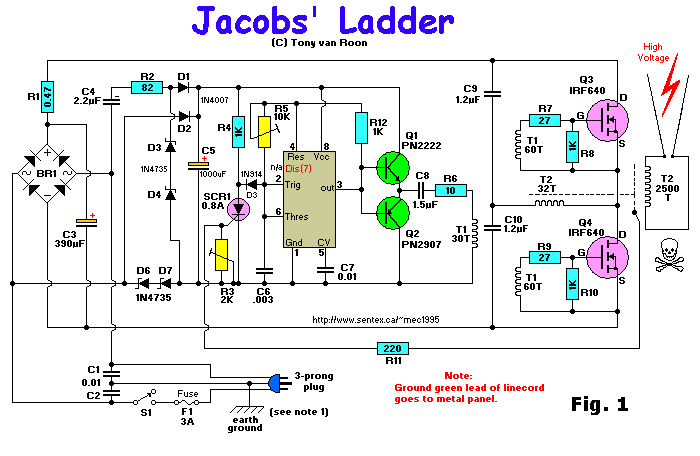
Parts List:
All resistors are 1/4W, 10%, unless otherwise indicated.
R1 = 0.47 ohm, 2 watt
R2 = 82 ohm, 2 watt
R3 = 2K, PC mount trimmer
R4,R8,R10,R12 = 1K
R5 = 10K, PC mount trimmer
R6 = 10 ohms, 1/4 watt
R7,R9 = 27 ohms
R11 = 220 ohms
Capacitors:
C1,C2 = 0.01uF, 1000V, ceramic
C3 = 390uF, 200V, electrolytic
C4 = 2.2uF, 250V, metalized polyester
C5 = 1000uF, 25V, electrolytic
C6 = 0.003uF, 50V, polyester film
C7 = 0.01uF, 50V, ceramic
C8 = 1.5uF, 100V, metalized polyester
C9,C10 = 1.2uF, 400V, metalized polyester
Semiconductors:
BR1 = bridge rectifier, 4A, SIP
D1,D2 = 1N4007, 1000V, 1A, diode
D3 = 1N914, silicon signal diode
D4-D7 = 1N4735, 6.2V, 1W
SCR1 = 0.8A, 200V, sensitive gate, TO-92, Teccor EC103B1 or equivalent
Q1 = 2N2222, NPN transistor
Q2 = 2N2907, PNP transistor
Q3,Q4 = IRF640, N-channel power MOSFET, 200V, 10A, Intern'l Rectifier or equiv.
IC1 = 555 timer/oscillator
Magnetics:
T1 = Driver transformer, 30 turns primary, 60 turns secondary (see text)
T2 = Output transformer, half bridge, 32 turns pri., 2500 turns sec. (see text)
Other Components:
S1 = Switch , SPST, panel mount, 10A, pull chain
F1 = Fuse, 3A, slow-blow
Miscellaneous:
PCB or perforated board (see text); U-chassis (see text); mirror; metallized
plastic (see text); transparent plastic covers (see text; L-Panel (see text);
stainless steel strips, 0.060-inch thick; 18-1/2 inches (see text) insulating
blocks (see text); 2-feet high-voltage wire, 15 kilo-volt rating; 3-wire power
cord with line plug; fuse holder; phenolic transformer insulator (see text);
hookup wire; miscellaneous nuts, screws; rubber feet (4); linecord grommet;
silicone grease; TO-220 mica washers; solder.
Notes:
The following parts and kits are available from Innovation Unlimited, Box 716,
Amherst, N.H. 03031; Telephone 603-673-4730 or FAX 603-672-5405:
Kit of electronic components and circuit board, less transformers--$69.50
Assembled and tested electronic circuit board--$89.50
Assembled and tested driver transformer T1--$9.50
Cores and bobbins for driver transformer T1--$4.50
Assembled and tested high-voltage transformer T2--$24.50
Cores, bobbins, and potting cap for high-voltage transformer--$14.50
High-voltage wire (15KV)--$0.50/foot
Teflon insulating blocks (2 required)--$5.00
(Tony's comment: Prices for the above are copied the way they were published
in "Electronics Now" and may not be accurate anymore since dated from 1995.
Also, although Innovation Unlimited still exists, there is no guarantee they
are still selling the kits.)
Jacobs Ladder, HV, Tesla, Wimshurst, Voltage Doublers, Kirlian, Lightning Bulb, Van de Graaff
12,000 Volt Supply:
The operation of the Jacob's Ladder depends on the current limited power supply that delivers 12,000 volts at 40
milliamperes from the 120 volt AC line. Refer to the schematic diagram of Fig. 1. The
full-wave bridge BR1 rectifies the 120 volt AC line input, and resistor R1 limits the DC charging current of capacitor
C3 to a safe value. The Jacob's Ladder project is powered by 150 to 160 volts DC derived from the 120 volt AC line.
The drive circuit power is obtained by dropping the 120 volt AC line through capacitor C4 and current limiting resistor
R2. Diodes D1 and D2 alternately conduct only in the positive direction, and their DC output pulses are integrated by
filter capacitor C5. Zener diodes D4 and D5 regulate these DC pulses to peak values of 15 volts DC.
Capacitor C4 and resistor R2 present a complex impedance so that most of the AC line voltage is dropped across the
reactance. This configuration eliminated the waste of real power and heat losses that would have occurred by dropping
the line voltage with only a resistor.
The 555 timer IC1 is configured as a square-wave oscillator. The output frequency of its square waves is determined
by the setting of the trimmer potentiometer R5 and capacitor C6. The frequency is is about 25 kHz for the values of
R5 and C6 shown in Fig. 1. Resistor R12 limits the high-frequency setting to an
acceptable value. Potentiometer R5 can be used to adjust the circuit's power output. Increasing the frequency
reduces the circuit's output by increasing the inductive reactance of the transformer leakage inductance.
The output of IC1 on output pin 3 appears at the bases of the current "source", NPN transistor Q1 and "sink" PNP
transistor Q2. The emitters of this transistor pair are AC-coupled through capacitor C8 and resistor R6 to drive the
primary of driver-isolation transformer T1. This drive prevents DC from flowing thought the primary. Resistor R6
dampens any overshoot that results from transformer T1's leakage inductance.
The scheme provides a satisfactory source for driving the high gate-to-source capacitance of the two NPN switching
power MOSFETs, Q3 and Q4. Transformer T1 is wound on a high permeability core with as few turns as possible to
eliminate leakage inductance.
The gate circuits of MOSFETs Q3 and Q4 contain 27-ohm resistors (R7 and R9) to slow their switching times. This
eliminates possible parasitic oscillations that could occur if the MOSFETs were switched at their speed limit.
Output transformer T2 has a half-bridge configuration so that MOSFETs Q3 and Q4 are only subjected to half of the
rectified DC line voltage, or about 80 volts. Assuming that the voltage midway between capacitors C9 and C10 is about
half of 160 volts (or about 80 volts), when Q3 turns on, the charge on C9 causes current to flow through T2 in one
direction.
When Q3 turns off, Q4 turns on, dumping the charge on C10 through T2 in the opposite direction. This drives the
magnetic flux of T2 evenly and symmetrically, making full use of T2's core capability. The primary of output
transformer T2 contains 32 turns, but its secondary contains 2500 turns. The ratio of these turns is approximately 1
to 78. When multiplied by the rectified line voltage of 160 volts DC, an output of about 12,000 volts peak volts is
obtained across the secondary.
This 12,000 volt output is the peak open-circuit voltage of the system, and it produces a short-circuit current of
approximately 40 milliamperes. This current is limited by the leakage inductance caused by the loose magnetic coupling
between the primary and secondary circuits of transformer T2. This leakage inductance can be controlled to some extent
by placing air gaps between the cores, changing the reluctance of the magnetic circuit.
Safety Provisions:
Because this project is operated from the 120 volt AC line, fault and safety shutdown provisions are included. They
are provided by silicon controlled rectifier SCR1 connected as shown in Fig. 1 with its anode in series with diode D3.
When the gate current reaches a specified threshold, the SCR is triggered on and latched by holding current through
resistor R4. Trigger pin 2 and Threshold pin 6 of IC1 are now clamped to ground, thus preventing
oscillation and turning off the circuit.
The signal current for the gate of SCR1 is obtained from the capacitive connection to the actual core of the output
transformer T2. This connection is made by winding three to four turns of insulated hookup wire around the core of
transformer T2. In effect, it is a capacitive wire pick-up probe. As long as output power is flowing between the
output connections of T2, the Jacob's Ladder will continue to operate.
If, for some reason, one of the output leads (vee strips) is grounded, a return current is forced to flow by capacitive
action between the core of transformer T2 through the wrapped-wire pick-up probe. This current then turns on SCR1,
shutting down the Jacob's Ladder.
Building the Circuit:
The high-voltage power supply circuitry for the Jacob's Ladder can be built by point-to-point wiring methods on a
5-1/2X2-1/4 inch piece of standard perforated circuit boards (holes spaced 0.10 inch on centers) or on a circuit board
available from the source given in the Parts List. Drill mounting holes in the four corners of the circuit board
before inserting any electronic components.
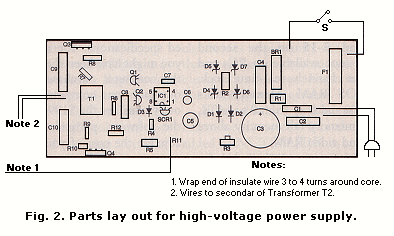
All of the electronic components with the exception of transformers T1 and T2 are standard, off-the-shelf components
available from electronics stores and mail-order distributors. However, the transformers must be custom wound. Both
transformers, completely wound and tested, are available from the source given in the Parts List. Alternatively, you
can wind your own transformers if you have some experience in doing this. Some useful information on winding these
transformers and material selection is given later in this article under the heading, "Winding the Transformers."
Refer to the schematic in Fig. 1 and parts layout diagram Fig. 2.
The parts layout diagram gives the approximate locations of all components except for switch S1 and transformer T2,
which are off-board components. There is nothing critical about parts placement, and suggest layout of Fig. 2
is based on keeping interconnecting wiring as short as practical. Be sure to make the gate connection go MOSFETs Q3
and Q4 as short and direct as possible.
Begin by inserting and soldering all components except MOSFETs Q3 and Q4. Observe the correct polarities for all
silicon diodes (D1 to D3), Zener diodes (D4 and D5), and electrolytic capacitors (C3 and C5. If you wire point-to-point,
do not trim the leads of the components until you have made use of as many excess leads lengths as is practical to form
interconnections between components.
Then insert the TO-220 packaged MOSFETs Q3 and Q4 close to the outer edges of the circuit board in the locations shown
in Fig. 2, with their metal tabs are facing outward. In a later step, the tabs of Q3 and
Q4 will be fastened to the sides of a U-shaped channel that functions both as a heat sink and as a support for the
circuit board.
Carefully examen all the electronic components on the board to be sure that they are correctly placed and oriented.
Examen all solder joints to verify that there are no inadvertent solder bridges or cold solder joints (a joint
soldered too fast and does not adhere properly). Make any corrections at this time before proceeding. Then set the
completed circuit board aside.
Jacobs Ladder, HV, Tesla, Wimshurst, Voltage Doublers, Kirlian, Lightning Bulb, Van de Graaff
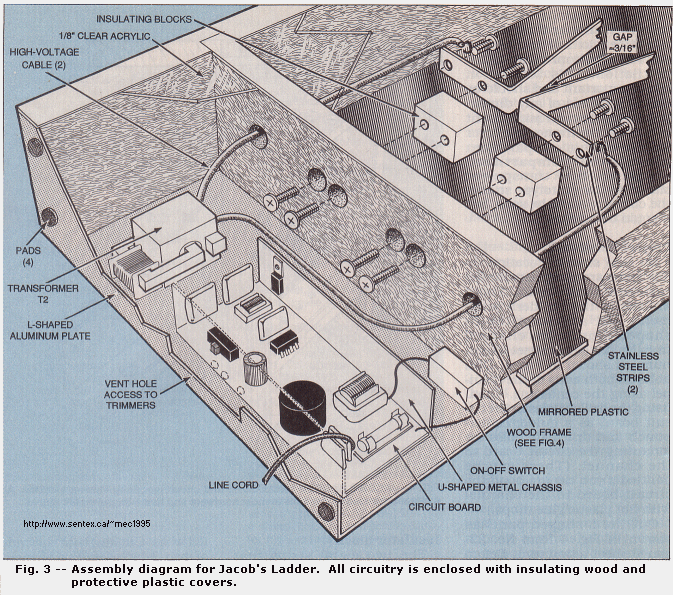
Product Enclosure:
Figure 3 illustrates the author's enclosure for the Jacob's Ladder project. It was
designed to meet two objectives: 1. to meet all reasonable safety requirements by providing adequate insulation between
people and flammable materials and the enclosed high-voltage circuitry, while at the same time protecting the
circuitry form dust and dirt. 2. to be simple enough to be made by persons with minimal carpentry skills form
materials readily available at hardware and home-improvement stores.
Many variations on the author's enclosure design are possible including changes in exterior and interior dimensions
and the substitution of more expensive wood for the framing. However, it is imperative that all provisions for
ventilating both the circuitry and the vee "ladder" to dissipate any heat buildup be followed, but make sure that
those spaces are not large enough to admit fingers or the small hands of curious children.
The overall case dimensions are 24 x 12.5 x 4 inches. The closed H-shaped frame was made from 3/4-inch thick x 4-inch
wide soft wood. Slots that are 1/8-inch wide and 1/4 deep were milled 1/8-inch in from each edge of the inside
surfaces of the frame members to accommodate protective transparent plastic covers on the front side and a metalized
plastic mirror on the back side. (These protective sheets could be fastened directly to the case edges with screws.)
The bottom of the case and the back of the lower circuit/transformer compartment is covered by an L-shaped aluminum
plate that serves as the vertical support for the circuit board and output transformer. Holes drilled in the bottom of
this plate permit circuit ventilation and access to the on-board trimmer potentiometer R3 and R5. Another hole id
formed in the back of the plate for mounting on-off pull switch S1.
Figure 4 provides general information on the sizes and shapes of the principal wood and
aluminum parts. Notice the holes drilled in the top member of the frame for cooling the ladder compartment. The
author's prototype frame was made by assembling the wooden frame with screws after the clear 1/8-inch plastic front
windows and rear mirror were cut to fit the milled slots.
The transparent plastic cover for the ladder compartment was cut 1-inch shorter than the inside dimensions of the
frame to provide a bottom opening for ventilation. This ventilation slot is important and should be there regardless
of any dimensional changes you might want to make in the frame. The cover for the circuit compartment protects that
compartment completely. It is transparent plastic in the prototype so that the circuitry could be seen, but it could
be opaque.
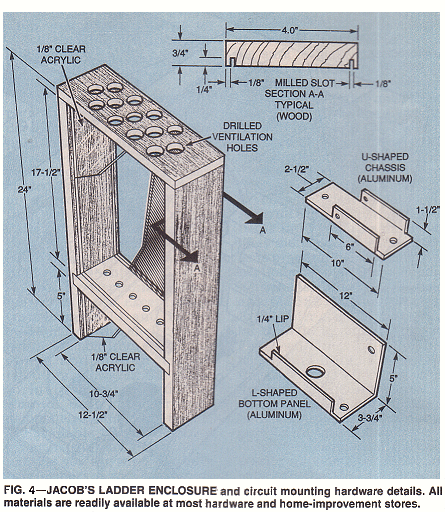
Project Metalwork:
No hole sizes or location dimensions are given here for the enclosure components. Those are left to the builder's
judgment. Cut and form the U-shaped aluminum channel from No. 22 gauge sheet aluminum, as shown in Figure 4.
Drill hole in both ends of the channel along the centerline. Then, using the drilled holes in the circuit board as a
guide, center-punch and drill four holes for mounting the circuit board to the channel. (These can be omitted if you
elect to bond the circuit board to the channel with hot plastic glue drops.)
Cut the L-shaped panel as shown in Figure 4 from No 22 gauge sheet aluminum. Before
bending the front lip of folding the plate, drill 1-inch diameter holes for circuit cooling and access to trimmer
potentiometers R3 and R5. Above the fold line, drill another hole for the linecord (powercord), large enough to admit
a rubber or plastic grommet, and drill a hole to accommodate chain-pull switch S1. Then bend the flat plate 90°
along the fold line and bend up the front lip.
Drill two holes evenly spaced within 2 inches of the ends of the stainless steel "ladder" strips, and bend those 2-inch
long sections approximately 90° with respect to the rest of the strips. Note: Stainless steel was selected for the
ladder strips because the electric arcs will not cause the strips to oxidize or corrode, and tests showed that
stainless steel permits easier starting of the arcs than other metals.
Insulator Blocks:
The two metal strips that form the "ladder" must be mounted on insulators that have high dielectric strength. The
insulators in the prototype were made from Teflon blocks that measure 1-1/4x1x3/4 inch high. This material can be
drilled and tapped, and it is strong enough to withstand the heat created by electric arcs. Individual Teflon blocks
are available from the source in the Parts List.
Project Assembly:
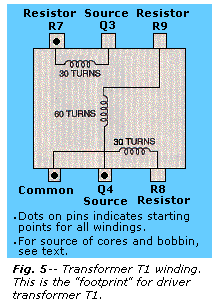 With the completed circuit board inserted in the channel, elevated slightly above the bottom of the channel, mark,
centerpunch and drill the holes in each side wall for fastening the tabs of MOSFETs Q3 and Q4. Be sure to deburr and
perhaps countersink slightly the holes in the channel so that the tabs on the MOSFETs will be clamped securely against
the channel walls. Cut and trim the ends of two 3-inch lengths of insulated, stranded linecord to the circuit board,
as shown in Fig. 2, to make the connections with the linecord. Insert and solder the ends
of the wires on on-off switch S1.
With the completed circuit board inserted in the channel, elevated slightly above the bottom of the channel, mark,
centerpunch and drill the holes in each side wall for fastening the tabs of MOSFETs Q3 and Q4. Be sure to deburr and
perhaps countersink slightly the holes in the channel so that the tabs on the MOSFETs will be clamped securely against
the channel walls. Cut and trim the ends of two 3-inch lengths of insulated, stranded linecord to the circuit board,
as shown in Fig. 2, to make the connections with the linecord. Insert and solder the ends
of the wires on on-off switch S1.
Attach the circuit board to the U-channel with screws and nuts, using several nuts as standoffs to isolate the circuit
board from the channel. Align the tabs of MOSFETs Q3 and Q4 with the holes in the sidewalls of the channel, insert
insulating mica washers with a film of silicone grease between each tab and the channel walls, and fasten them with
screws and nuts.
Cut a 2-1/2 inch square of phenolic laminate or circuit board stock between the base of transformer T2 and the bottom
of the channel. Bond the transformer to the insulator and channel base with epoxy or hot glue.
Drill two holes through the wooden frame member between the two compartments, and insulating blocks. Drill a singe
hole in the opposite sides of each block and fasten the ladder as shown in Fig. 3.
Then attach the insulation blocks and strips to the frame member with screws. Fasten the bent metal strips so that
they are offset by about 30°, as shown in Fig. 3. The base strips are diagonal across
the insulator blocks so that the corner edges are separated by about 3/16 inch. The upper ends of the strips should be
about 2 inches apart.
Fasten the channel with transformer T2 and the circuit board to the L-shaped panel with screws and nuts, as shown in
Fig. 3. Complete the installation of switch S1 and the linecord with a grommet, and
complete all soldering. Be sure the L-shaped metal panel is hard-wire connected to the earth ground by means of the
green wire within the three-wire power-cord. Assemble the enclosure with its plastic covers and aluminum base plate.
The Jacob's Ladder is now complete.
Adjusting the Ladder:
Carefully examine your work to be sure that there are no inadvertent short circuits of cold solder joints. The circuit
is now ready for testing. First, adjust potentiometer R5 as follows:
1. Disconnect one end of R1 to Q3.
2. Connect an oscilloscope to the Q4 gate.
3. Plug in power cord and turn on power.
4. Adjust R5 for a period of 40nS so 15-volt squarewaves are symmetrical.
5. Shut off power, reconnect R1, and connect the oscilloscope to the Q4 drain.
Turn on power. A near perfect squarewave should appear, and it should remain
constant as arcs form and reform.
Adjusting procedure for the ground-fault potentiometer R3 to shut off the circuit if there is ground-fault current:
1. Turn off power and set wiper of R3 for maximum sensitivity.
2. Disconnect a high-voltage lead from a ladder strip, and connect it to ten
1-watt, 100 kilo-ohm resistors in series. (This simulates a 10-milliampere
ground current.)
3. Apply power and verify that the circuit shuts down. Turn off power, adjust R3
slightly clockwise. Reapply power until high voltage stays on. Note: allow
time for C3 to discharge before re-applying power or SCR1 will stay on.
Jacobs Ladder, HV, Tesla, Wimshurst, Voltage Doublers, Kirlian, Lightning Bulb, Van de Graaff
Winding the Transformers:
Figure 5 is a "footprint" diagram of drive transformer T1 with callouts that can be
related to those found on the schematic Fig. 1. The cores and bobbins for this
transformer are from Philips (Ferroxcube) Components, Saugerties, NY). The cores are No. E187 made from 3E2A molded
ferrite material. The plastic molded bobbins are Part No. E187PCB1-8. These parts are available from the source given
in the Parts List.
Transformer T1: Wind the first 30 turns trifilar (three wires in parallel) from No. 30 AWG magnet wire and the
remaining 30 turns as single wire turns. Solder the ends of the windings to the pins, insert the E-core, and tape the
assembly together securely.
Transformer T2: The core of transformer is No. 4162S from Samhwa USA, Chatsworth CA, with matching seven segment
bobbin, cup and primary bobbin. These parts are also available from the source given in the Parts List.
Start winding the secondary bobbin by securing the magnet wire to a pin insulated on the bobbin end and wind between
300 and 400 turns of No. 37 AWG magnet wire on each of seven segments. Snap the cup in place and solder the output leads.
Fill the cup with epoxy or RTV Silicone when you are satisfied that the transformer has been wound correctly.
Wind eight turns of No. 30 twisted wires on the primary bobbin and tape the windings in place. Form the air gap of
the primary section with 0.005-inch thick Mylar tape and form the air gap for the secondary section with 0.010-inch
thick Mylar tape. Tape of clamp the two sections together with a heavy rubber band.
Parts List:
All resistors are 1/4-watt, 10%, unless otherwise noted
R1 = 0.47 ohms, 2 Watt
R2 = 82 ohms, 2 Watt
R3 = 2K, trimmer potentiometer
R4,R8,R10,R12 = 1K
R5 = 10K
R6 = 10 ohms
R7,R9 = 27 ohms
R11 = 220 ohms
Capacitors:
C1 = 0.022uF, 50WVDC metalized film
C3-C12 = 0.001uF, 2000WVDC ceramic disk
C13 = 220uF, 25V, electrolytic
C14 = 4700uF, 35WVDC, electrolytic
Note: There is no C2.
Semiconductors:
D1-D10 = 1N4007, 1A, 1000PIV, silicon rectifiers connected in series (see text)
D11 = 1N4007, 1A, 1000PIV, silicon rectifier
Q1 = TIP31A, Darlington transistor
U1 = MC1458BAL hex, inverting Schmitt trigger, IC
BR1 = 6A, 50PIV, full wave bridge rectifier
Led1 = Jumbo green light emitting diode
Other Components:
Ne1 = Ne2 neon lamp
T1 = Ferrite core step-up transformer (see text)
T2 = 12 Volt, 2A, power transformer
PL1 = 117 volt AC plug with line cord
Perfboard materials, enclosure, battery, heat sink, IC sockets, battery, wire,
Battery, Battery holder, solder, hardware, etc.
Please Note: don't ask for additional information. This is all there is. Don't email me or leave
messages in regards to this project in the "Message Forum"; they will be deleted without prior notification.
NO I don't sell a kit, NO I don't have a pcb either. The 'suggested' parts lay-out diagram refers to
perforated board. Meaning, you do point-to-point wiring and soldering.
However, on the positive side, I may try to put a kit together with all parts and maybe a pcb if there is enough interest.
Copyright and credits:
This article originally appeared in "Electronics Now" magazine, December 1995. It was written by the author
Robert Iannini. Published by Gernsback Publishing. (Gernsback Publishing is no longer in business).
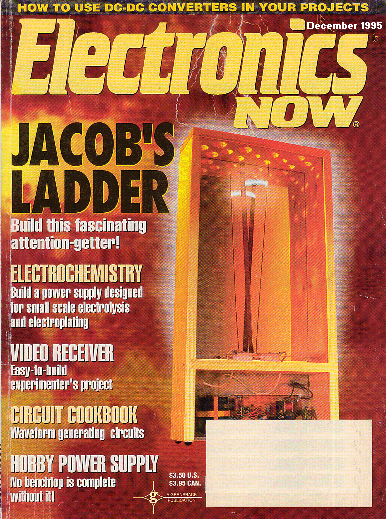
Editor's note and Disclaimer: The device carries lethal high voltage and
carelessness can be dangerous to your health. Build and/or use at your own risk. The Sentex Corporation of Cambridge
Ontario, host of "Tony's Website", or Tony van Roon himself, cannot be held liable or responsible or will accept any
type of liability in any event, in case of injury or even death by building and/or using or misuse of this device or
any other high-voltage device posted on this web site. By accessing, reading, printing, or building the unit in this
article you agree to be solely responsible and agree with the above stated disclaimer.
Jacobs Ladder, HV, Tesla, Wimshurst, Voltage Doublers, Kirlian, Lightning Bulb, Van de Graaff
Back to High Voltage Projects Index
Copyright © 2005 - Tony van Roon
Last Updated July 24, 2010






 With the completed circuit board inserted in the channel, elevated slightly above the bottom of the channel, mark,
centerpunch and drill the holes in each side wall for fastening the tabs of MOSFETs Q3 and Q4. Be sure to deburr and
perhaps countersink slightly the holes in the channel so that the tabs on the MOSFETs will be clamped securely against
the channel walls. Cut and trim the ends of two 3-inch lengths of insulated, stranded linecord to the circuit board,
as shown in Fig. 2, to make the connections with the linecord. Insert and solder the ends
of the wires on on-off switch S1.
With the completed circuit board inserted in the channel, elevated slightly above the bottom of the channel, mark,
centerpunch and drill the holes in each side wall for fastening the tabs of MOSFETs Q3 and Q4. Be sure to deburr and
perhaps countersink slightly the holes in the channel so that the tabs on the MOSFETs will be clamped securely against
the channel walls. Cut and trim the ends of two 3-inch lengths of insulated, stranded linecord to the circuit board,
as shown in Fig. 2, to make the connections with the linecord. Insert and solder the ends
of the wires on on-off switch S1.